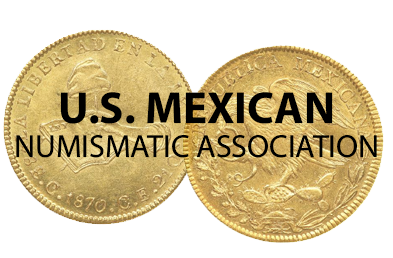Fifty centavos coins (1905-1983)
The 50 centavos coins were made in nine basic types:
Type 1 - .800
Type 2 - .800, reduced
Type 3 - .720
Type 4 - .420
Type 5 – Cuauhtémoc
Type 6 – Big Cuauhtémoc
Type 7 - Copper-nickel
Type 8 – Stylised Eagle
Type 9 - Palenque
Type 1 - .800
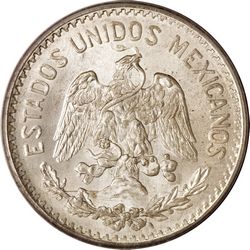
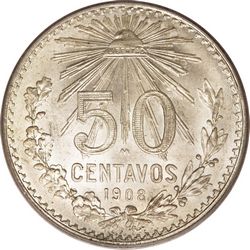
KM-445 1908 50c
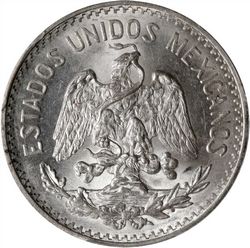
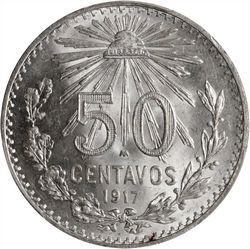
KM-445 1917 50c (Stack’s-Bowers auction, 23 February 2022, lot 74844)
These coins, authorised by the decrees of 25 March 25 and 5 April 1905, had a small radiant Liberty cap. Their composition was 80% silver and 20% copper. Weight was 12.5g and diameter was 30 mm. Mintage was
| Year | Mintage | |
| 1905 | 2,446,000 | |
| 1906 | 16,966,000 | open 9, closed 9 |
| 1907 | 33,761,239 | curved 7, straight 7 |
| 1908 | 488,000 | |
| 1912 | 3,736,000 | |
| 1913 | 10,510,000 | 13 over 07, 3 over 2 |
| 1914 | 7,710,000 | narrow date, wide date |
| 1916 | 480,000 | first 1 over inverted 1 |
| 1917 | 37,112,000 | |
| 1918 | 1,320,000 |
In the coins of 1906 and 1907 part of the minting was carried out in mints in the United States.
Overdate
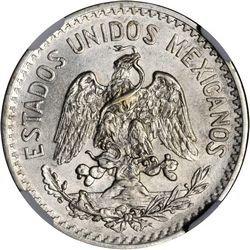
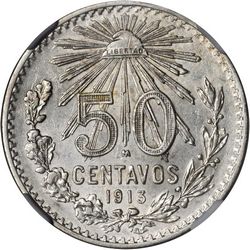
KM-428 1913 50c 13 over 07 (Stack’s Bowers ANA auction, 7 August 2017, lot 22891)
Type 2 - .800, reduced
KM-446
On 13 November 1918 Venustiano Carranza reduced the silver content of Mexico’s coins. The reason given in his decreeDiario Oficial, 14 November 1918 were that
(a) as a result of the rise in the global price of silver, the pesos fuertes had long since been driven out from circulation, and the functions of the fractional silver coinage had been hindered by their increasing tendency to disappear;
(b) this was due to unavoidable economic causes, and so the government was unable to prevent the disappearance of the fractional coinage. The remedy was, therefore, to reduce the quantity of pure silver contained in the fractional coin in such a way that there was no inducement to export, recast or simply hide This was all the more acceptable as the fractional coinage had only a representative value, as an auxiliary to the gold coins, that were the basis of the monetary system.
(c) that, since the old silver pesos had disappeared from circulation for some time, there was no longer any reason to consider them as part of the monetary system; and that, since it was desirable to fractional coins worth one peso, it was necessary to demonetize the old silver pesos, thus completing and consolidating the monetary regime established on 25 March 1905, through the country's definitive entry into gold monometallism.
This coin has the same design as Type 1 but is 3 mm smaller in diameter (27 mm). Their weight was 9.06 g. Mintage was 2,760,000 in 1918 and 29,670,000 in 1919.
When Plutarco Calles authorised the new 10c coin in 1925, he also decreed that the silver 10c, 20c, 50c and $1 coins created by the 13 November 1918 law should be legal tender up to the end of 1925Diario Oficial de la Federación, Tomo XXX, Núm. 3, 6 May 1925.
Overdate
A 8 over 7 overdate is known.
Type 3 - .720
On 27 October 1919 Venustiano Carranza noted that the continuing rise in the price of silver threatened the disappearance of the one-peso, fifty-, twenty-, and ten-centavo coins created by the previous year’s law, and that the government needed to ensure a supply of such coinage to maintain daily commercial transactions, and so issued a new decree, altering the composition of the 20c, 50c and $1 coins and introducing a new bronze 10c pieceDiario Oficial, 31 October 1919.
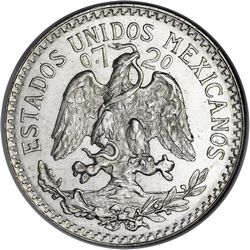
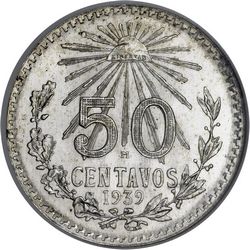
KM-447 1939 50c
The high prices of silver continued and so the 50c coin continued to undergo changes. A decree of 27 October 1919 changed its weight from 9.06 g to 8.33 g and its silver content from 80% to 72%. Mintage was
| Year | Mintage |
| 1919 | 10,200,000 |
| 1920 | 27,166,000 |
| 1921 | 21,864,000 |
| 1925 | 3,280,000 |
| 1937 | 20,000,000 |
| 1938 | 100,000 |
| 1939 | 10,440,000 |
| 1942 | 800,000 |
| 1943 | 41,512,000 |
| 1944 | 55,806,000 |
| 1945 | 56,766,000 |
Type 4
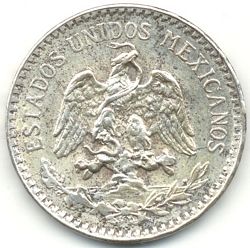
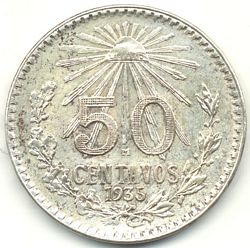
KM-448 1935 50c
In 1935 with the unprecedented rise in the price of silver the intrinsic value of coins exceeded their nominal value and this led to hoarding and melting down for a profit. So, on 22 May 1935 Lázaro Cárdenas changed the specifications of the 50c coinsDiario Oficial de la Federación, Tomo XC, Núm. 18, 25 May 1925. The new coin, issued with a date of 1935, had an even further reduced silver content, of 42% silver and 58% copper. Weight was 7.973 g and diameter 27 mm.. Mintage was 70,800,000 and these coins were minted in Denver and Philadelphia as well as Mexico City.
This issue was demonetized on 28 August 1936 so it only lasted 15 months.
On 11 September 1947 Miguel Alemán changed the specifications for the 50c, $1 and $5 silver coinsDiario Oficial de la Federación, Tomo CLXIV, Núm. 16, 19 September 1947 but the 50c piece was not issued. Many patterns were prepared by the mint in Mexico City (a copper nickel 50 centavos, 1945, featuring Juárez (Luna-PL-15); a silver peso, 1947, featuring Morelos (Luna-PL-16}; a silver peso, 1947, featuring Juárez (Luna-PL-17}, and a silver five pesos, 1947, featuring scales (Luna-PL-18)). Despite the known 1945 50 centavos pattern, the government decree foresaw a different design and metal. Pablo Luna Herrera, in his 2018 bookLas Pruebas de la Moneda Mexicana del Siglo XX, 2018, p. 344 disclosed a die from the Mexican Mint collection with a very similar appearance with the bust of Juarez and the inscriptions that the decree set forth. A struck example, however, was not known until a possibly unique pattern was found.


KM-Unlisted, Silver 50 Centavos Pattern, 1947 (Stack’s-Bowers auction . 26 August 2022, lot 34466)
Type 5 – Cuauhtémoc
On 29 December 1949, after the devaluation of the peso, Miguel Aleman issued a decree changing the designs of the denominations up to and including the $1 valueDiario Oficial de la Federación, 30 December 1949.
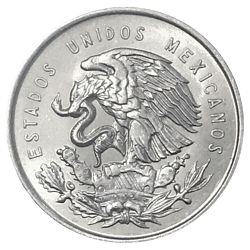
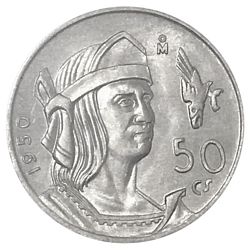
KM-449 1950 50c
The new 50c coin was minted with the image of the Aztec emperor Cuauhtémoc. These had a composition of 50% copper, 30% silver, 10% nickel and 10% zinc. Weight was 6.666 g and diameter 26mm. Mintage was 13,570,000 in 1950 and 3,650,000 in 1951.
Type 6 – Big Cuauhtémoc
On 13 September 1955 Adolfo Ruiz Cortines issued a decree giving the characteristics of new coins of 1c, 5c, 10c, 20c, 50c $1, $5 and $10Diario Oficial, 15 September 1955.
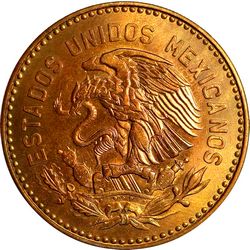
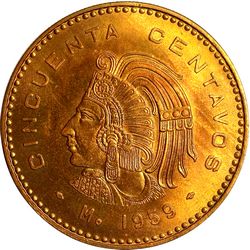
KM-450 1959 50c
So, after four years without minting a 50-centavo coin, one without silver was minted for the first time. These were 7 mm larger (33 mm) in diameter than Type 5. These had a composition of 95% copper, 2.5% tin and 2.5% zinc. Weight was 14 g. Mintage was
| Year | Mintage |
| 1955 | 3,502,000 |
| 1956 | 34,643,000 |
| 1957 | 9,675,000 |
| 1959 | 4,540,000 |
Type 7 - Copper-nickel
On 27 December 1963 Adolfo López Mateo changed the design of the 25c and 50c coinsDiario Oficial, Tomo CCLXI, No. 49, 30 December 1963
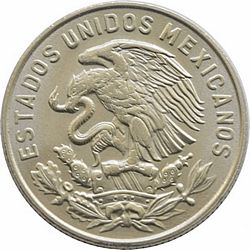
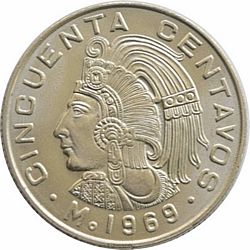
KM-451 1969 50c
These were like Type 6, but composed of 75% copper and 25% nickel and 8 mm smaller in diameter. They weighed 6.5 g and had a diameter of 25 mm. Mintage was
| Year | Mintage |
| 1964 | 43,806,000 |
| 1965 | 14,326,000 |
| 1966 | 1,726,000 |
| 1967 | 55,244,000 |
| 1968 | 80,438,000 |
| 1969 | 87,640,000 |
Type 8 – Stylised eagle
On 27 December 1969 Gustavo Díaz Ordaz authorised a new series of coinage from the one centavo to the twenty-five pesoDiario Oficial, 30 December 1969.
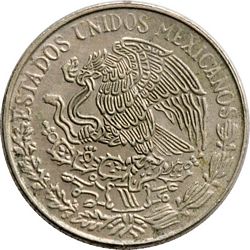
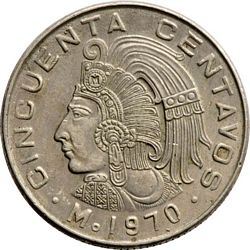
KM-452 1970 50c
These were like Type 7, but with the obverse redesigned such that all the devices are depicted as raised outlines on a flat surface, rather than as fully contoured shapes. Mintage was
| Year | Mintage |
| 1970 | 76,236,000 |
| 1971 | 125,288,000 |
| 1972 | 16,000,000 |
| 1975 | 177,958,000 |
| 1976 | 37,480,000 |
| 1977 | 12,410,000 |
| 1978 | 85,400,000 |
| 1979 | 229,000,000 |
| 1980 | 89,978,000 |
| 1981 | 142,212,000 |
| 1982 | 45,474,000 |
| 1983 | 90,318,000 |
Type 9 – Palenque
By 1983 with accelerating inflation 50 centavos was of little use but the Mexican government made a final coin of this denomination, smaller than the previous one and only minted in 1983. These were authorised by decrees of 7 January 1980 and 28 December 1981.
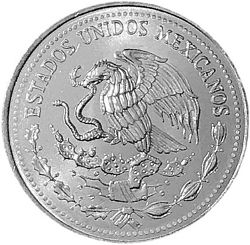
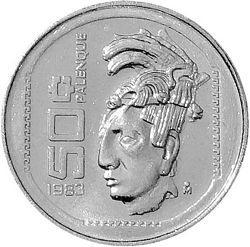
KM-492 1983 50c
These were composed of stainless steel, and weighed 4.2 g. Mintage was 99,540,000 in 1983.
They are known with Thick Snake and Thin Snake.
